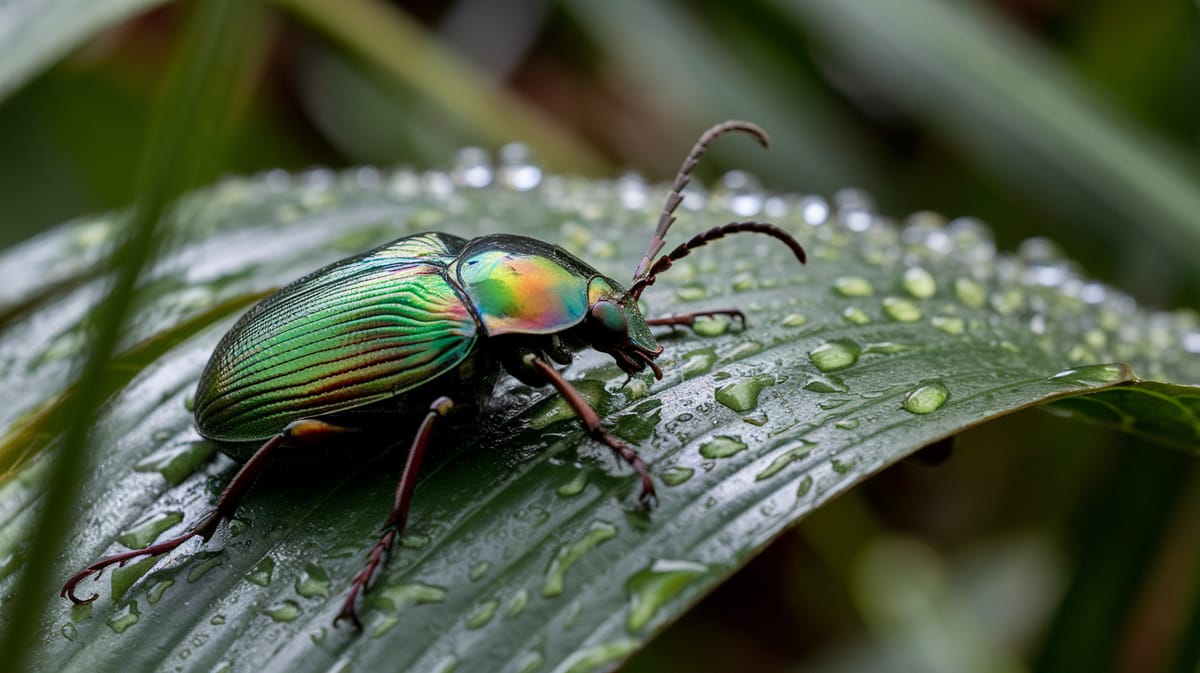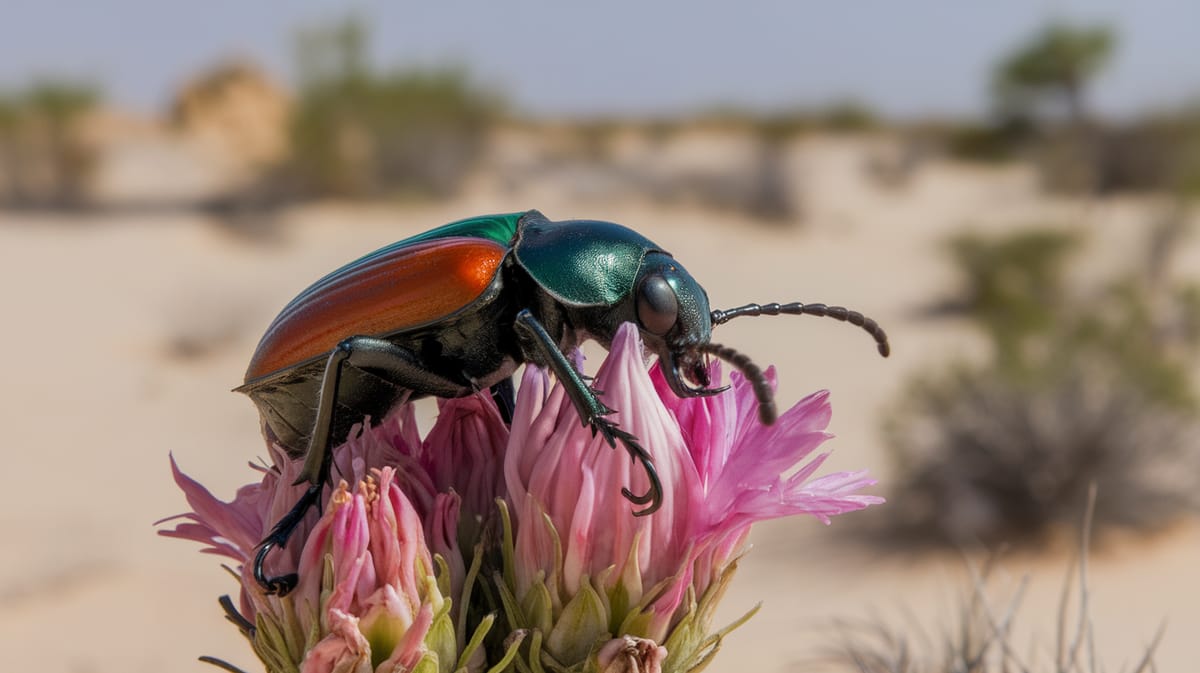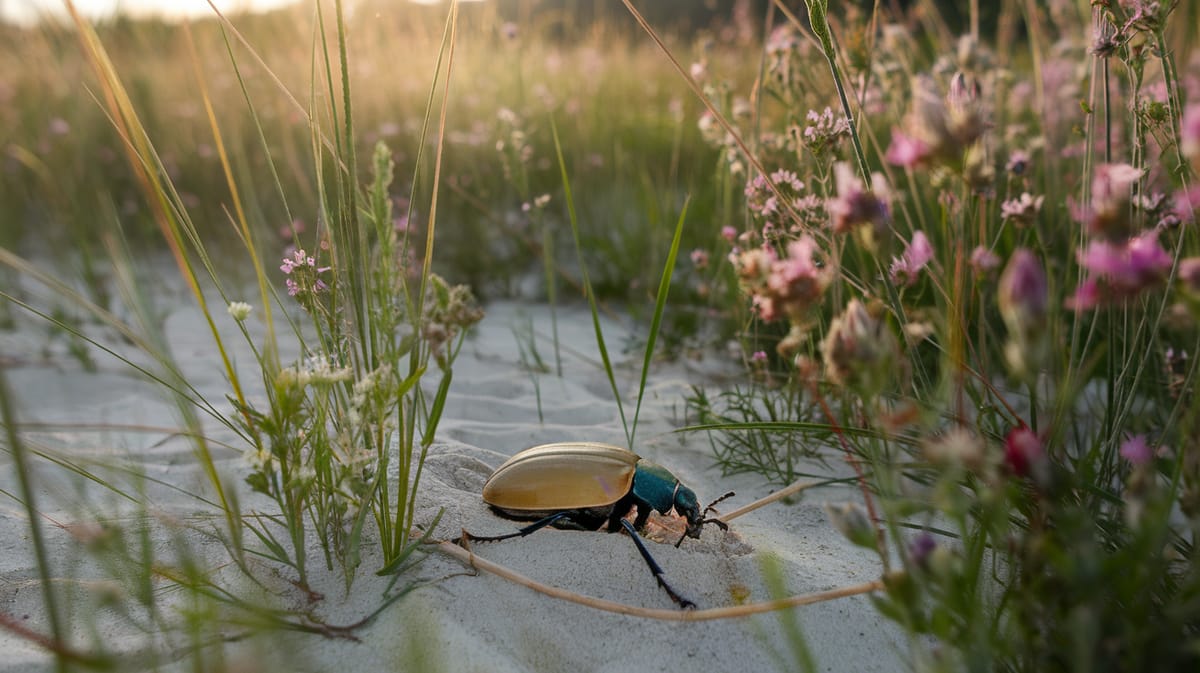Blister Beetle
Armored and vibrant, the Blister Beetle wields a powerful chemical defense that deters predators. Playing a crucial ecological role, its larvae parasitize bee nests, controlling their populations.

Key Insights at a Glance
Did You Know?
Taxonomy & Classification
Blister beetles are known for their defensive secretion of cantharidin, a potent chemical that deters predators and can cause skin blistering. Let's understand the evolutionary journey and classification of these remarkable herbivores, parasites.
Species Diversity
Comprising over 2,500 species across 120 genera, blister beetles exhibit significant diversity, thriving in varied environments worldwide.
Resilient Survivors
Originating around 100 million years ago, blister beetles have adapted through major climatic changes, maintaining their ecological niche over time.
Lifecycle and Growth
A remarkable journey of transformation from Egg to Adult.
Egg
Laid in soil or plant debris, the eggs develop protected by their environment until larvae emerge ready for their journey.
Larva
The larvae, known as triungulins, actively seek out bee nests to consume larvae and pollen as they grow.
Pupa
Securely encased underground, the pupa undergoes metamorphosis, transforming into the distinctive adult form of the beetle.
Adult
The adult beetle emerges with striking colors and releases toxic chemicals as a defense mechanism against predators.
Dietary Habits
A foliage feeder with distinct strategies, this insect primarily targets plant matter, occasionally consuming insect larvae for sustenance.
| DIET TYPE | DESCRIPTION |
|---|---|
| Primary Diet | Primarily feeds on leaves, flowers, and stems of various plants, often causing significant agricultural damage. |
| Secondary Diet | Sometimes consumes insect larvae, utilizing them as a supplementary protein source when plant material is scarce. |
| Occasional | Occasionally ingests nectar and pollen, particularly during flowering seasons, expanding its nutritional intake opportunistically. |

Behaviour and Adaptations
Discover the fascinating adaptations that make the Blister Beetle a master of survival.
Chemical Defense
Produces cantharidin, a potent toxin, deterring predators effectively.
Reflex Bleeding
Releases irritating hemolymph when threatened, startling predators.
Lifecycle Manipulation
Larvae parasitize bee nests, exploiting resources for growth.
Ecosystem Impact
The Blister Beetle plays a crucial role in sustaining ecological balance through its unique contributions.
Predator of Grasshopper Eggs
Consumes grasshopper eggs, helping control their population naturally.
Nutrient Cycling Facilitator
Contributes to nutrient cycling by decomposing plant materials.
Biodiversity Promoter
Provides food for various predators, supporting biodiversity.
Conservation Challenges
Understanding and addressing the major threats to Blister Beetle populations.
Chemical Exposure
Pesticides disrupt beetle life cycles and habitats severely.
Habitat Loss
Agricultural expansion destroys essential beetle habitats.
Climate Change
Altered weather patterns affect beetle breeding and survival.
Frequently Asked Questions
How long do Blister Beetle live?
Blister Beetles typically live for a few months, depending on environmental conditions and species. Their life cycle includes egg, larval, pupal, and adult stages, with the adult stage being the shortest, often lasting a few weeks to a few months.
What do Blister Beetle eat?
As adults, Blister Beetles feed on flowers and leaves, often targeting crops like alfalfa. Larvae consume grasshopper eggs and other soft-bodied insects, contributing to pest control in agricultural settings.
Are Blister Beetle poisonous?
Yes, Blister Beetles produce a toxic compound called cantharidin, which can cause skin blistering upon contact. Ingesting them, especially by livestock, can result in severe poisoning and even death.
Are Blister Beetle endangered?
Blister Beetles are not generally considered endangered. They are widespread and abundant in many regions. However, specific species may face threats due to habitat loss and environmental changes.
What do Blister Beetle symbolize?
In some cultures, Blister Beetles symbolize transformation or renewal due to their life cycle. Their ability to produce cantharidin has also led to associations with healing and medicinal use in historical contexts.
Do Blister Beetle bite?
Blister Beetles do not bite humans. Their primary defense mechanism is the release of cantharidin, which can cause skin irritation or blistering if handled.
What color are Blister Beetle?
Blister Beetles can be found in various colors, including black, gray, metallic blue, and yellow. Some species have bright, warning coloration to deter predators.
Does a Blister Beetle have wings?
Yes, Blister Beetles have wings. They possess two pairs of wings, with the front pair being hard and protective, covering the more delicate hind wings used for flying.
What does a Blister Beetle look like?
Blister Beetles are elongated insects with soft bodies and distinctively narrow necks. They have long antennae and can vary in color, often exhibiting bright or metallic hues.
Is a Blister Beetle an insect?
Yes, Blister Beetles are insects. They belong to the family Meloidae within the order Coleoptera, which is the group commonly known as beetles.
Related Insects
Discover insects with similar characteristics to Blister Beetle - including shared habitats, diets, and taxonomic classifications
Share this profile
Help others discover Blister Beetle
